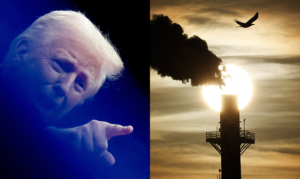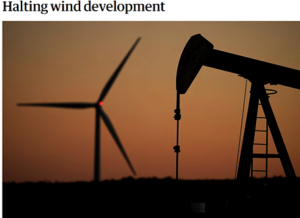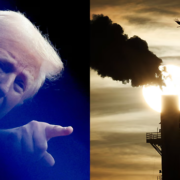A National Energy Policy Reversal
Through a flurry of executive orders, Donald Trump has made clear his support for the re-ascendancy of fossil fuels. He has dismantled national policy support for an orderly transition into a competitive and advanced clean energy economy. He has also damaged the United States’ global leadership in the fight to contain an escalating climate crisis now sweeping America, and the world.
 “We will drill, baby, drill,” the president said in his inaugural address, and so far he has stuck to his rhetoric.
“We will drill, baby, drill,” the president said in his inaugural address, and so far he has stuck to his rhetoric.
Climate treaties, solar and wind energy technology, and even electric vehicles increasingly produced in the United States are not part of Trump’s energy agenda. His about face energy policy for the Country is to simply roll back the clock to an energy time and place long since obsolete, costly, and destructive to America and the world. In the first weeks of 2025, President Trump proudly proclaimed, “We’re bringing back coal”.
Trump energy priorities in his second term have also included attacks on energy efficiency in all its various and productive forms from home appliances to national power grid. In effect, directing Americans to pay for more fuel just to keep the lights on, compounded by policy actions ranging from mandating energy-inefficient appliances to advancing fuel-inefficient transportation and in the burning more fossil fuels.
Scientists continue to tell global leaders (and most are listening) the world must urgently move away from fossil fuels to avoid the ever-worsening impacts of a growing global climate crisis, as evidenced by last year being the hottest ever recorded and Los Angeles suffering ruinous wildfires.
For those not listening or just engaged in wishful thinking, these are wonderful moments of the Trump presidency. It certainly has been a good time for fossil fuel executives who poured tens of millions of dollars into Trump’s election campaign, in what has been another example of polluter interests participating in the Trump “pay-to-play” presidency.
In the first days of his presidency, Trump was on fire, as he declared an unfounded “national energy emergency” and opened the flood gates to overriding executive actions meant to boost an already-booming and heavily subsidized fossil fuel industry.
Trump’s first order of business in this round-two presidency was to invoke the so-called “National Emergencies Act” that unlocked an array of executive powers designed to fast-track the production and distribution of (dirty) energy. It has been a continuing Trump policy payback to the fossil fuel industry’s for its overwhelming financial support of Trump’s second successful run for the presidency. Trump’s long-awaited energy emergency outraged climate advocates. “There is no energy emergency,” said Manish Bapna, president and CEO of the green non-profit Natural Resources Defense Council. “There is a climate emergency.”
In short, Trump’s number one energy priority at this moment in history; do what US fossil fuel interests want: remove energy safeguards, roll back environmental protections and pollution containment regulations, and certainly do everything possible to increase domestic dirty energy production and demand.
Breaking News, August 15th
Trump’s orders to keep obsolete and inefficient fossil fuel power plants open slated for closure. The move will cost taxpayers and ratepayers alike, billions of dollars.
President Donald Trump’s order to keep large fossil-fueled power stations scheduled to retire between now and 2028 operating indefinitely will cost ratepayers across the United States $3.1 billion per year, according to new research from the consultancy Grid Strategies on behalf of four large environmental groups.
If the Department of Energy expands the order to cover all 54 fossil fuel plants slated for closure in the next three years, the price tag for Americans whose rates fund the subsidies to keep the stations running would rise to $6 billion per year. The order to keep large fossil-fueled power stations scheduled to retire between now and 2028 operating “indefinitely”. The agency’s existing mandate “perversely incentivize plant owners to claim they plan to retire so they can receive a ratepayer subsidy to remain open,” the report points out.
Round Two – roll back America’s emerging clean energy economy
“President Trump’s plan to keep the US hooked on fossil fuels under the guise of ‘energy dominance’ will line the pocketbooks of billionaires and fossil fuel companies,” said Ashfaq Khalfan, climate justice director at the charity Oxfam America.
The oil and gas industry donated more than $75m to Trump’s campaign, a pay-to-play financial bonanza for Trump. Immediately being sworn as the 47th president, and in one fell swoop, Trump rescinded numerous Biden era executive actions, including ones focused on climate-related financial risk, protecting the Arctic and boosting multilateral climate action.
In 2021, then President Biden guided his administration resources towards addressing a growing national risk, specifically, a growing climate crisis which poses numerous risks to the US economy. He directed government officials to push for “accurate disclosure of climate-related financial risks”, and called on regulators to consider measures to boost those disclosures.
More than a slap in the face to all Americans, Trump’s present day backwards-facing energy priorities are tone-deaf to the lessons of the past, and thus are without merit. It recently has been a full stop on progress and lessons-learned in the governing responsibilities covering environmental, climate, and national energy priorities. Previous U.S. energy policies based years of national scientific and commercial investments in the advancement of America’s transition into a clean, healthy and prosperous energy economy and are in this President’s crosshairs for elimination.
Blow’in.., in the Wind
Trump has also long viewed wind energy with disdain, calling the sight of turbines “disgusting” and blaming them, misleadingly, for causing disproportionate deaths of birds and whales.
 Trump has targeted, in a full-stop maneuver, policies enabling nation’s nascent offshore Wind Energy sector. Using false reasoning that denies the facts, Trump claims turbines are killing thousands of whales, but this president’s executive order is more than a Wind energy ban on ocean projects, he has gone further by placing a freeze on all permits for wind projects on both land and sea.
Trump has targeted, in a full-stop maneuver, policies enabling nation’s nascent offshore Wind Energy sector. Using false reasoning that denies the facts, Trump claims turbines are killing thousands of whales, but this president’s executive order is more than a Wind energy ban on ocean projects, he has gone further by placing a freeze on all permits for wind projects on both land and sea.
Trump has also repeatedly demonstrated his disdain for the truth. All things associated with America’s growing clean energy economy are not exempt from this disdain and are in the new president’s crosshairs. Trump also overturned two key Biden energy policies designed to restrict fossil fuel development, in favor lower cost and zero emissions energy options facing forward, not backwards, in America’s energy policy.
One policy former Biden president enabled earlier (with substantial support from US coastal states) was to withdraw swaths of the US coasts from future oil and gas drilling (thereby eliminate the threat of pollution spills) included the entire US east coast, the eastern Gulf of Mexico, parts of the US Pacific Coast, including portions of Alaska’s Bering Sea.
Trump has long derided green policies and repeatedly called the climate crisis a “hoax”.
As Trump returned to office, we’ve witnessed the deadly price tag of fossil fuel industry’s control over our democracy,” said Elizabeth Bast, executive director of the research and advocacy group Oil Change International, adding that “…Thousands of (fossil fuel) drilling permits are currently going unused.” Trump energy policy is simply designed to expand oil and gas extraction, Bast said. Moves so far that have been met with ire from scientists and environmentalists, and much of the public.
Andy Moderow, senior director of policy at the non-profit Alaska Wilderness League, called Trump’s go-backwards energy policy as a “slap in the face to science, the American public and Indigenous communities who seek land protections”.
Electrifying Results
President Biden’s signature legislative accomplishments was the bipartisan passage of the Inflation Reduction Act (IRA) in 2022. The Act included a $7.5bn plan to build EV-charging stations and it enabled America’s transition into the 21st century, and in this case, addressing the elimination of auto emissions pollution and advancing lower cost (clean fuel) personal transportation for all Americans, which by extension addresses a national climate crisis and its growing financial and social consequences to the United States, and the world.
Emissions regulations finalized by Biden’s administration (which Trump labeled an “EV mandate”) do not directly require the production of electric vehicles, but it was a major and enabling step for forward America’s auto industry and consumers alike. It was good for the economy, good for consumers, and good for the planet – a win-win all the way around.
Immediately returning to office, Trump took direct aim at the IRA, and more specifically, federal support for electric vehicles and clean energy, considered a direct challenge to the fossil fuel sector. Trump’s response shortly after taking power was to overturn Biden executive orders and the IRA, with its goal of achieving an outcome of half of all new vehicles sold in 2030 would be electric and fossil fuel-free.
“We will end the Green New Deal, and we will revoke the electric vehicle mandate, saving our auto industry,” he said in an address at the rotunda. What trump failed to note was US auto industry’s major accomplishment in quickly transitioning to electric drivetrains and battery powered vehicles, a direct by product of the industry’s investment, technology, and global leadership in a rapid transition to electrification.
In an executive order, Trump said his administration will halt the distribution of unspent government funds for vehicle charging stations and called for the end of a waiver for states to adopt stricter auto-emission rules by 2035. Later followed, by the premature sun setting of consumer EV rebates, costly to both Americans budgets and the US auto industry inn what is an unqualified reversal in American technology and consumer choice. . . .
Some of Trump’s EV-Impacted Regulatory Rollbacks:
Rescinds the federal target of 50% EV sales by 2030.
- Eliminates; Oct 1, 2025, for qualified taxpayers, EV rebates of $7,500 for new electric vehicle purchases, and $4,000 for used EV purchases.
Pauses funding for charging infrastructure and federal incentives for new charging stations.
Ends regulatory penalties for automakers failing to reach fuel economy (CAFE) standards, removing a key motivator for manufacturers to produce more EVs
Immediate Impacts on EV Sales
Short-Term Surge: EV sales have spiked in recent months, with consumers “rushing out” to buy before the tax credit deadline. July 2025 saw nearly 130,100 new EVs sold—a 20% jump over July 2024, and a record for monthly EV market share at 9.1%.
Total EV sales for H1 2025: 607,089 (up just 1.5% year-over-year), but Q2 saw a 6.3% Y/Y decline, reflecting growing market uncertainty.
Expected Drop: Analysts forecast a dramatic plunge in sales following the September 30 expiration, with 4Q 2025 likely experiencing a “collapse” as the market adjusts to a new policy landscape without incentives.
Market predictions suggest U.S. EV sales could fall by over 40% through 2030, as half of EV buyers have relied on tax credits to afford these vehicles.
Industry and Consumer Impact
Automakers Rethink Strategy: Major manufacturers (Ford, GM, startups) have dialed back planned EV production, likely shifting focus toward hybrids or conventional gasoline vehicles—especially models that may benefit from new auto loan interest deductions favoring lower-cost domestic gas cars.
The attacks on the electric vehicle industrial sector is a major set-back for America’s manufacturing, technology, and auto sectors, and is already creating turmoil among American’s top vehicle manufacturers who have invested billions in the transition away from gas-powered vehicles.
Trump’s unqualified executive orders are already imperiling US climate sector leadership and accomplishments towards a clean energy economy. Transportation is the largest contributor to US planet-heating emissions and a major source of health-harming pollution. “Rolling back vehicle emission safeguards harms our health, our wallets and our climate,” Katherine García, who directs the clean transit program at the green group Sierra Club, said.




Leave a Reply
Join the Community discussion now - your email address will not be published, remains secure and confidential. Mahalo.